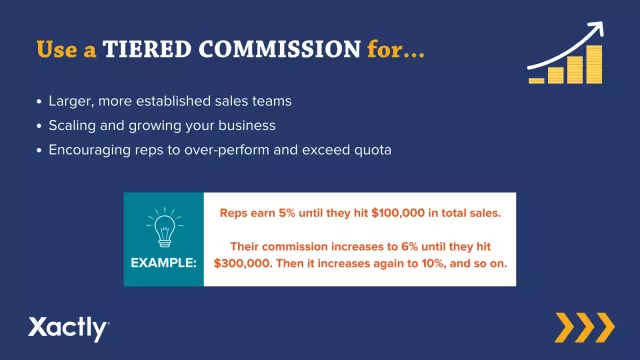
There are many ways to incentivize a sales team—bonuses, SPIFs, commissions, etc. Regardless of your strategy, the goal is the same: to motivate sales reps to close deals and hit their quota in the most profitable way.
The most common form of sales compensation and motivation is through a sales commission structure. Tiered commissions are a form of sales commission structure that helps encourage reps to continuously improve their sales performance to meet and exceed quota.
What is a Tiered Commission Structure?
A tiered commission structure motivates reps using commission rate tiers. Unlike flat commission plans, tiered commissions encourage sales reps to hit sales milestones. As a seller’s performance increases, they earn a higher commission.
For example, let’s say at the start of a new fiscal year, reps will earn a six percent base commission on every deal until they sell $100,000 in total revenue. After that, they’ll earn seven percent until they sell $250,000, at which point they’ll move up to eight percent, and so on.
This type of compensation plan is meant to motivate reps to meet quota and ideally, continue closing deals to exceed their goals. Tiered commission structures are effective because the more they sell, the more reps benefit.
Designing a Tiered Commission Structure
Tiered commission plans are fairly easy to design: the steps are to 1) set a quota, 2) set pay sales milestones 3) assign increasing payout rates for each milestone. As always, it's important to ensure that the increasing payouts are still profitable for the firm, or you might run into some big problems. This specific plan design allows flexibility in your incentive design, and you can be as specific as you want.
For example, a more complex tiered commission structure may have set revenue thresholds like the example we described earlier. Or it can be as simple as:
- One rate for below quota
- A rate when above quota
- A third rate for significant over-achievement (e.g. >200% of quota)
Tier measurement can be based on the number of deals/units, total revenue/profits, new customers, etc. A few companies go so far as to offer the higher rate for every deal closed, going back to the first one of the year (often called a “back to dollar one” rule, or retroactive payout rule). However, most plans pay the higher rate for each marginal addition to performance, and not back to the first deal.
When Should You Use a Tiered Commission Structure?
In short, like many business questions, the answer is it depends. Companies often put tiered commission structures into play when they feel that the flat-rate plan is not driving the desired performance. Thus, they opt for a tiered commission plan where they can specifically reward top performers and, at the same time, motivate "the middle" tier to increase their performance.
Tiered commission structures are extremely effective at motivating sellers to over-perform and exceed quota, and they work best for larger, established sales teams as they scale and grow their business.
Seeing True ROI From Your Incentive Compensation
Your sales incentives play a huge role in your ability to drive seller performance and hit revenue and growth goals. When using a tiered commission structure, you’re providing strategic incentives that motivate reps to over-perform.
But without the right data or tools on hand, it’s difficult to determine the effectiveness of your compensation plans. Using automated incentive compensation like Xactly Incent opens the door to extensive analysis capabilities. You can view up-to-date performance at any point in time, and reps can see their earned commissions in real-time.
Intelligent tools will also help you understand how to improve your commission structures to drive more revenue and provide flexibility to adjust plans quickly and strategically when market or economic conditions shift unexpectedly” to “Intelligent tools such as Xactly's Incent will also help you understand how to improve your sales commission structures to drive more revenue and provide flexibility when market or economic conditions shift unexpectedly
To learn more about intelligent sales compensation planning, download our “2021 Guide to Successfully Managing Sales Compensation.”

